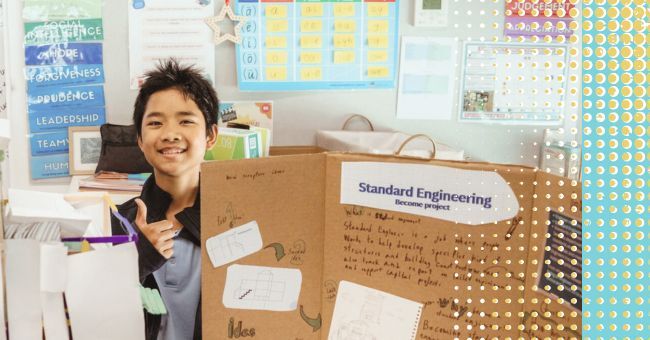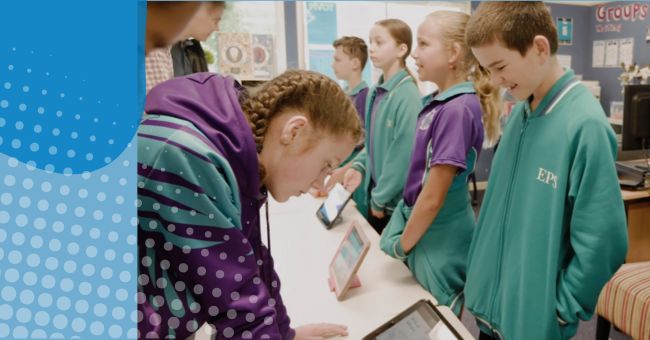What does a Whole-School Approach to Careers Ed Look Like?
Quick quiz! What does your school's motto or slogan say? Got it in mind? Great. Now here's the important bit: Does the school slogan relate to the...
9 min read
 Marian Wright
:
Oct 1, 2025 12:00:00 PM
Marian Wright
:
Oct 1, 2025 12:00:00 PM

Across Australia, young people sit in classrooms and wonder what their futures might hold. Marian Wright digs deep into what ACARA's decision about Work Studies and the curriculum really means in classrooms.
Marian Wright is an educator, strategist, and design partner working with schools to design schooling that makes sense for humans, systems, and the future. In 2026, she will launch Coherence Co-Lab, a strategy and design consultancy aimed at helping schools create systems that are responsive to the future and coherent and connected in the present.
 Across Australia, young people sit in classrooms and wonder what their futures might hold. Some are dreaming big. Others are unsure or overwhelmed. And some have stopped believing that school has anything to do with their future at all.
Across Australia, young people sit in classrooms and wonder what their futures might hold. Some are dreaming big. Others are unsure or overwhelmed. And some have stopped believing that school has anything to do with their future at all.
I’ve spent the last few years working with schools to rethink how learning is designed so young people can explore possibilities and build a future with purpose from the earliest years.
This is why when ACARA announced their decision not to update the Work Studies curriculum and instead develop a Curriculum Connection, I had mixed feelings. These decisions are so much more than documents – they will shape what happens in classrooms all over the country, and as a result, shape how young people perceive their futures and the value of schooling.
My initial response was concern.
What does this decision mean for a world where young people face increased uncertainty, and where research from the OECD (2025) shows that current aspirations are often misaligned with the realities of the labour market?
What message does this send to schools, young people and their families about the kind of learning that matters in a world that’s incredibly complex and won’t stop evolving?
If a Curriculum Connection is optional (as was the case with the implementation of Work Studies, to be fair), and students’ experiences depend on the choices of individual schools and educators, will this further perpetuate the inequity (Groves, Austin, O'Shea, & Lamanna, 2021) that already exists around career education and guidance in schools?
But then, I felt a little hope.
Re-framing career learning as something that is interconnected and relevant across learning areas could be a positive shift. Learning about careers is so much more than VET, work readiness and subject selection. Careers are a summation of the journey we take through life – therefore career education encompasses identity development, change management, critical thinking skills and more. This isn’t something that should exist on the periphery, when it is so obviously intertwined in the daily experiences of young people. A Curriculum Connection could offer a starting point for positioning career education this way.
I feel torn about the road ahead. If we continue to treat school-based career education as optional or a tokenistic add-on, we risk reinforcing the belief that classroom learning has nothing to do with careers and life beyond school. At the same time, I am cautiously hopeful that a career education as a Curriculum Connection could be a well-placed lever to shift this pattern, but this depends on whether schools recognise its significance and embed it deeply and meaningfully across all year levels and the wider school system.
My work with schools is underpinned by systems thinking, a mindset and set of tools that emphasise the interconnected nature of the world. Donella Meadows, a leading thinker and writer in this field, wrote that, “a system isn’t just any old collection of things. It’s an interconnected set of elements that are coherently organised in a way that achieves something” (Meadows, 2008, p.11).
Schools are a perfect example of this; they are dynamic, complex systems where the parts are deeply interconnected and are, to an extent, organised coherently around a goal. I see this complexity most clearly when working with schools to embed career education across their schooling system. It quickly becomes obvious that career education can’t be dropped in as a standalone initiative. In fact, organisational theorist Russell Ackoff emphasised this: you can’t improve a whole system by only improving its parts (Ackoff, Addison & Carey, 2010).
It’s through this systems lens that I’d like to explore ACARA’s decision and consider the opportunity it presents for schools to think differently about career education.
For clarity, when I refer to a system in this piece, I am drawing on the definitions of people like Donella Meadows, Russell Ackoff, and Peter Senge: a set of interconnected elements whose structure, purpose, and interactions produce patterns of behaviour over time. This is distinct from the way we use the term ‘system’ in education, which often denotes a bureaucracy, administration or a network of schools, such as the Catholic or State system.
One of my key takeaways from Donella Meadows’ work is that a system’s true purpose is revealed in how it behaves and the results it produces, not in the goals it claims to have.
 If we apply this to education, what is the story of our educational system in Australia? What is the story of our school systems? Many of us in schooling say that we want to empower and equip young people for the future, but if we look closely at the behaviour of our system and the results we produce and celebrate (and the fact that we often treat career education as an optional, sometimes expendable add-on), it reveals a very different purpose to the one we put on our websites and in our brochures.
If we apply this to education, what is the story of our educational system in Australia? What is the story of our school systems? Many of us in schooling say that we want to empower and equip young people for the future, but if we look closely at the behaviour of our system and the results we produce and celebrate (and the fact that we often treat career education as an optional, sometimes expendable add-on), it reveals a very different purpose to the one we put on our websites and in our brochures.
Moreover, the principle of purpose invites us to look beyond our stated goals in education and pay close attention to actual outcomes.
Across our pedagogies, learning areas, and subject design, are we supporting young people to become truly ‘future ready’ and to develop meaningful aspirations? Or is this something that we hope emerges naturally from a quality education? We also know that career education is so much more than VET and immediate post-school decision making. In fact, this was a finding of the 2019 review conducted by the Ithica Group in relation to career education and the Australian Curriculum. The full breadth of career education speaks to the core purpose of our work in education: helping young people find relevance in learning for today while building the confidence and agency to design a future in life and work.
Applying the lens of purpose to decisions around school-based career education invites us to be more strategic and considered about how we design learning that can actively develop our students’ futures.
The second systems principle to consider in this context is that of boundaries.
Boundaries are necessary to make sense of complexity in any system, but in schools, boundaries around subjects or role design can have unintended effects, segregating people and knowledge disciplines, leaving certain individuals responsible for specific domains of knowledge. A clear example of this is evident in most schools i.e. only the careers lead is responsible for careers; it is not the job of an English or History teacher.
In schools, boundaries shape the visible structures of schooling. They define and design constraints, and become an expression of values; a place where our mental models about what learning looks like and how it should be experienced really show up. Who is responsible? What is important? What is not? Who gets to decide? Ultimately, boundaries determine what we measure in schooling and what we decide to change.
Narrow boundaries around career education and the belief that it can only be reliably delivered in specific pieces of curriculum or at certain year levels, limit how career education is understood and experienced. For the record, school-based career education programs (separate from career advice and guidance) are proven to be critically important with significant impacts on the aspirations of young people and their engagement in schooling (Covacevich, Mann, Besa et al 2021). Programs that offer student-driven space in the timetable for young people to explore without academic pressure should be a core, not optional, inclusion in any school. Obviously, we need to get that right first.

But beyond that, we need to continue to widen the boundaries around career education and where it happens in schooling. Everything we do in schooling in some way shapes student motivation and agency, and as a result, affects engagement and motivation. We have an opportunity to make the connections between learning and careers explicit for young people so they can engage in knowledge and skill transfer across the domains of school, work, and find usefulness in the learning they are experiencing today.
Of course, we can’t discuss boundaries in schooling without acknowledging that school systems nest within other systems, and that our school-based decisions about curriculum design and delivery are by and large shaped by external bodies who deliver curriculum to us in segments and siloes. My own work is transdisciplinary – I draw from a range of knowledge bases across leadership, behavioural science and management to create new solutions for complex problems. Research by Spain (2019) shows that disciplines need other disciplines to be applied. Mathematical concepts and principles can be taught within the context of geography, economics, science or history, for example, enabling learners to create greater synthesis with the real world (Spain, 2019). These opportunities are already present within our curriculum, but it does fall to us to make these connections consistent and not just ad-hoc. Anytime we consider how one area of knowledge interacts with another to create innovations in the real world, we are building creative problem-solving skills that are essential for careers, and the complex issues in our world. When we partner with external stakeholders to build units of work that respond to issues in industry, we are exposing young people to authentic economic and labour information. This is, after all, exactly what research from the OECD invites us to do:
“How can we prepare students for jobs that have not yet been created, to tackle societal challenges that we can’t yet imagine, and to use technologies that have not yet been invented? …Evidence from quantitative studies suggest that important answers to these questions lie in making classroom walls more porous and drawing on workplaces and the economic community as deeper partners in student learning. In a world subject to rapid change, it is the people whose paid employment brings them into direct contact with the world of occupational change, who possess insights of special value to young people. As well as first-hand knowledge of the world as it is, they bring with them an authenticity which makes their perspectives difficult for young people to ignore.”
(Mann, Denis & Percy, 2020)
If boundaries around subjects and learning areas reflect the mental models we hold about how learning should be designed and delivered, then nothing will change unless we are willing to question whether those mental models still fit the world our students are navigating (Senge, 2006). But we must remember that progress and change don’t always come from adding new ideas on top of old ones - sometimes it requires unlearning and replacing deeply held beliefs and practices that no longer serve our students and the current reality (Kuhn, 2012; Grant, 2021).
In systems thinking, leverage points are specific places in a system where a small shift could have a big impact. They work at different depths: a small tweak might only have a shallow effect, while deeper change comes when multiple leverage points are addressed across the system. In schools, this could range from small adjustments, like changing a subject selection process or adding in a one-off careers event, to deeper shifts, like rethinking the mental models that shape how we structure learning.
I suppose this is where my cautious hope comes from. Positioning career education as a Curriculum Connection has the potential to be a powerful leverage point for change. But if it’s delivered in isolation, at only certain year levels, its impact will always be shallow. And without regulatory support to make career education mandated, explicit, and integrated, the responsibility falls to us, as individual schools and practitioners, to decide it matters and to act accordingly. That means committing to deliver explicit, integrated career education consistently and systematically from the earliest years of schooling – not because someone has told us to, but because we know it matters and it’s what our students urgently need.
 As a final reflection, I’d like to build on Kashefpakdel, Rehill, and Hughes’ (2018) notion that ignoring the process of career development in childhood is similar to a gardener disregarding the quality of the soil in which the garden will be planted.
As a final reflection, I’d like to build on Kashefpakdel, Rehill, and Hughes’ (2018) notion that ignoring the process of career development in childhood is similar to a gardener disregarding the quality of the soil in which the garden will be planted.
I believe this is equally true for schooling. We risk setting our students up for failure when we fail to acknowledge the process of career development in our learning and systems design.
Research from the UK (Chambers, Elnaz, & Rehill, 2018) reinforces exactly this point. Children are testing and internalising concepts of the future from as early as the age of five – we couldn’t stop them from engaging in the process of career development even if we wanted to.
So the question now is: what do we do next?
I think the debate around whether career education belongs in schools and curriculum is reaching its expiry date. While regulatory bodies may deem career education as optional, those of us working on the ground with young people who are watching the world change, know that it is not. We can wait for school-based career education to be mandated, or we can lead with courage now, embedding it at every level so that no young person’s future is left to chance.
References
Ackoff, R. L., Addison, H. J., & Carey, A. (2010). Systems thinking for curious managers. Triarchy Press.
Career Industry Council of Australia [CICA]. (2025). Australia’s Youth Deserve Better Than a ‘Curriculum Connection’. https://cica.org.au/wp-content/uploads/Australias-Youth-Deserve-Better-Than-a-Curriculum-Connection.pdf
Chambers, N., Elnaz, T. K., Rehill, J., & Percy, C. (2018) Drawing the Future: Exploring the career aspirations of primary school children from around the world. London: Education and Employers.
Covacevich, C., Mann, A., Besa, F., Diaz, J., & Santos, C. (2021). Thinking about the future: Career readiness insights from national longitudinal surveys and from practice (OECD Education Working Paper No. 248). OECD Publishing. https://dx.doi.org/10.1787/02a419de-en
Groves, O., Austin, K., O’Shea, S. et al. ‘One student might get one opportunity and then the next student won’t get anything like that’: Inequities in Australian career education and recommendations for a fairer future. Aust. Educ. Res. 50, 519–536 (2023). https://doi.org/10.1007/s13384-021-00468-2
Ithaca Group. (2019). Future Ready: Research on incorporating career education in the Australian Curriculum. Career Industry Council of Australia.
Kashefpakdel, E., Rehill, J. & Hughes, D. (2018). What Works? Career-related learning in Primary School. London: The Careers and Enterprise Company.
Mann, A., Denis, V. & Percy, C. (2020). Career ready? How schools can better prepare young people for working life in the era of COVID-19. OECD Working Papers No. 241. https://dx.doi.org/10.1787/e1503534-en
Meadows, D. H. (2008). Thinking in systems: A primer. Chelsea Green Publishing.
OECD. (2025). The state of global teenage career preparation. OECD Publishing. https://doi.org/10.1787/d5f8e3f2-en
Spain, S. (2019). Systems Thinking applied to curriculum and pedagogy: a review of the literature. Curriculum Perspectives. 39(135–145). https://doi.org/10.1007/s41297-019-00085-1
 Our new, dynamic short course showcases where and how all educators have a powerful impact on students' emerging ideas for the future, at whatever age. Join us online for this concise, evidence-based and contemporary quick deep-dive.
Our new, dynamic short course showcases where and how all educators have a powerful impact on students' emerging ideas for the future, at whatever age. Join us online for this concise, evidence-based and contemporary quick deep-dive.

Quick quiz! What does your school's motto or slogan say? Got it in mind? Great. Now here's the important bit: Does the school slogan relate to the...

How deeply are students asking why they are interested in certain occupations? At BECOME, we believe that asking why is absolutely vital. ‘Why’ is...

First published in the Sydney Morning Herald, August, 2024. School careers advisors are like a “backwards Google” and the tools they use are...